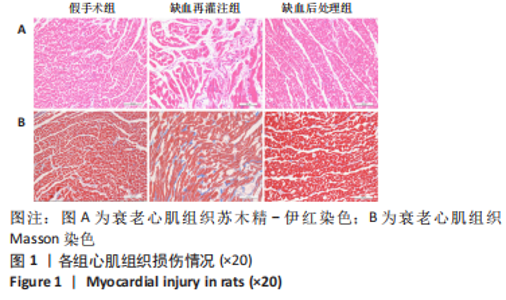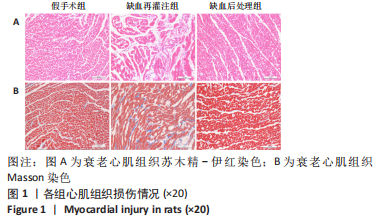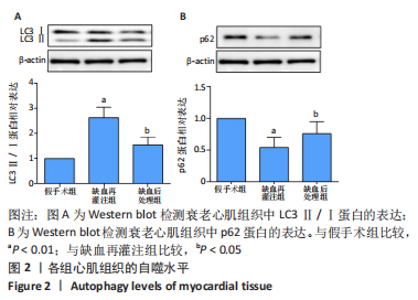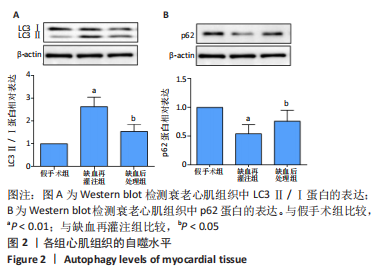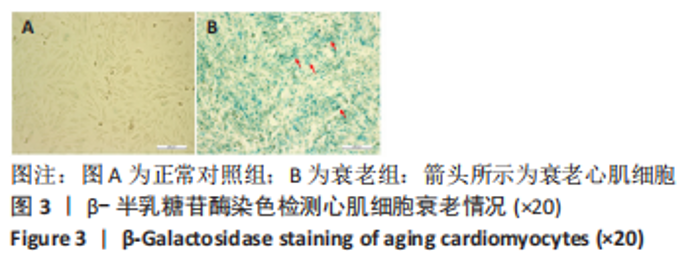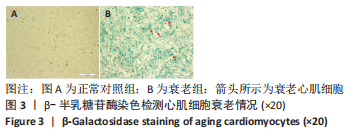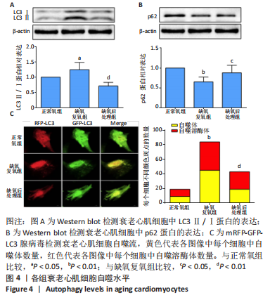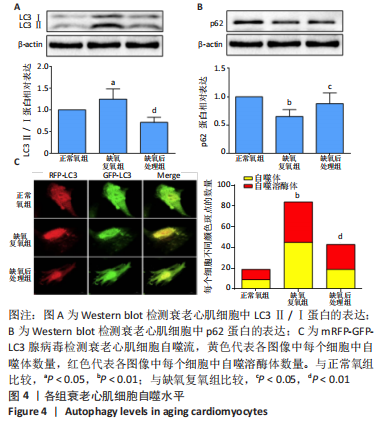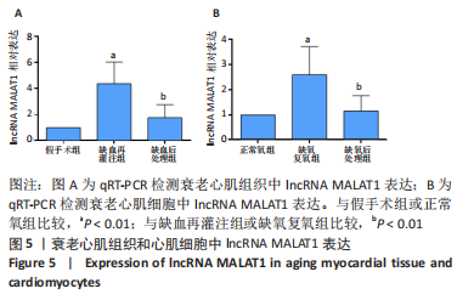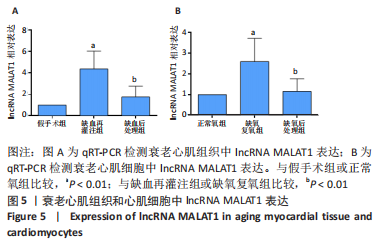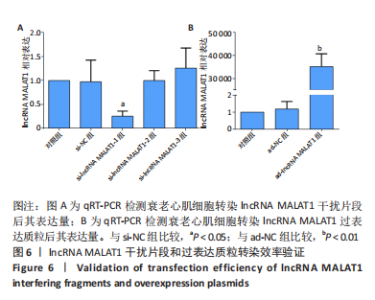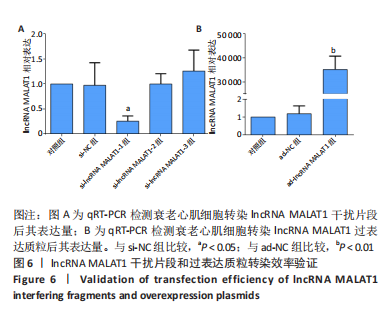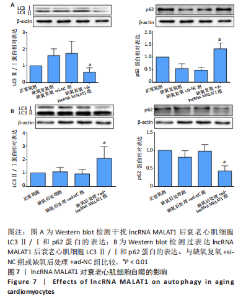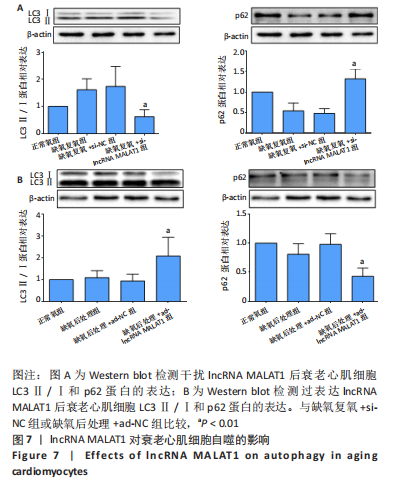Chinese Journal of Tissue Engineering Research ›› 2023, Vol. 27 ›› Issue (20): 3173-3179.doi: 10.12307/2023.478
Previous Articles Next Articles
Role of LncRNA MALAT1 in myocardial autophagy reduction in aging rats after ischemic postconditioning
Yang Huixia1, 3, Jie Yuzhen1, 3, Bai Zhigang3, 5, Jiao Yun3, 4, Yang Yong3, 5, Ma Tianlong2, 3, Ma Shengchao2, 3, Jiang Yideng2, 3
- 1Clinical Medical College, 2Basic Medical College, Ningxia Medical University, Yinchuan 750004, Ningxia Hui Autonomous Region, China; 3National Health Commission Key Laboratory of Metabolic Cardiovascular Disease Research, Yinchuan 750004, Ningxia Hui Autonomous Region, China; 4Department of Infection, General Hospital of Ningxia Medical University, Yinchuan 750004, Ningxia Hui Autonomous Region, China; 5People’s Hospital of Ningxia Hui Autonomous Region, Yinchuan 750004, Ningxia Hui Autonomous Region, China
-
Received:2022-06-24Accepted:2022-08-08Online:2023-07-18Published:2022-11-19 -
Contact:Jiang Yideng, MD, Professor, Basic Medical College, Ningxia Medical University, Yinchuan 750004, Ningxia Hui Autonomous Region, China; National Health Commission Key Laboratory of Metabolic Cardiovascular Disease Research, Yinchuan 750004, Ningxia Hui Autonomous Region, China Ma Shengchao, MD, Associate professor, Basic Medical College, Ningxia Medical University, Yinchuan 750004, Ningxia Hui Autonomous Region, China; National Health Commission Key Laboratory of Metabolic Cardiovascular Disease Research, Yinchuan 750004, Ningxia Hui Autonomous Region, China -
About author:Yang Huixia, Master candidate, Clinical Medical College, Ningxia Medical University, Yinchuan 750004, Ningxia Hui Autonomous Region, China; National Health Commission Key Laboratory of Metabolic Cardiovascular Disease Research, Yinchuan 750004, Ningxia Hui Autonomous Region, China -
Supported by:the National Natural Science Foundation of China, Nos. 81900273 (to MSC) and 81860044 (to YY); Ningxia Hui Autonomous Region Key R&D Programs, Nos. 2020BFH02001 (to BZG) and 2020BEG03005 (to JY)
CLC Number:
Cite this article
Yang Huixia, Jie Yuzhen, Bai Zhigang, Jiao Yun, Yang Yong, Ma Tianlong, Ma Shengchao, Jiang Yideng. Role of LncRNA MALAT1 in myocardial autophagy reduction in aging rats after ischemic postconditioning[J]. Chinese Journal of Tissue Engineering Research, 2023, 27(20): 3173-3179.
share this article
Add to citation manager EndNote|Reference Manager|ProCite|BibTeX|RefWorks
| [1] DING HS, YANG J, YANG J, et al. Fluvastatin attenuated ischemia/reperfusion-induced autophagy and apoptosis in cardiomyocytes through down-regulation HMGB1/TLR4 signaling pathway. Mol Biol Rep. 2021;48(5):3893-3901. [2] WANG R, WANG M, LIU B, et al. Calenduloside E protects against myocardial ischemia-reperfusion injury induced calcium overload by enhancing autophagy and inhibiting L-type Ca(2+) channels through BAG3. Biomed Pharmacother. 2022;145:112432. [3] PINELLI S, AGRINIER N, BOUCHAHDA N, et al. Myocardial reperfusion for acute myocardial infarction under an optimized antithrombotic medication: What can you expect in daily practice? Cardiovasc Revasc Med. 2018;19(7 Pt B):820-825. [4] FENG L, LIANG L, ZHANG S, et al. HMGB1 downregulation in retinal pigment epithelial cells protects against diabetic retinopathy through the autophagy-lysosome pathway. Autophagy. 2022;18(2):320-339. [5] ZHANG XW, ZHOU JC, PENG D, et al. Disrupting the TRIB3-SQSTM1 interaction reduces liver fibrosis by restoring autophagy and suppressing exosome-mediated HSC activation. Autophagy. 2020; 16(5):782-796. [6] TANG Y, HE X. Long non-coding RNAs in nasopharyngeal carcinoma: biological functions and clinical applications. Mol Cell Biochem. 2021; 476(9):3537-3550. [7] ZHENG YL, SONG G, GUO JB, et al. Interactions Among lncRNA/circRNA, miRNA, and mRNA in Musculoskeletal Degenerative Diseases. Front Cell Dev Biol. 2021;9:753931. [8] CHEN F, LI W, ZHANG D, et al. MALAT1 regulates hypertrophy of cardiomyocytes by modulating the miR-181a/HMGB2 pathway. Eur J Histochem. 2022;66(3):3426. [9] WANG S, YAO T, DENG F, et al. LncRNA MALAT1 Promotes Oxygen-Glucose Deprivation and Reoxygenation Induced Cardiomyocytes Injury Through Sponging miR-20b to Enhance beclin1-Mediated Autophagy. Cardiovasc Drugs Ther. 2019;33(6):675-686. [10] 徐灵博,郝银菊,丁宁,等.衰老心肌细胞缺氧后处理中miR-204的作用[J].广东医学,2017,38(18):2764-2767. [11] SEVERINO P, D’AMATO A, PUCCI M, et al. Ischemic Heart Disease Pathophysiology Paradigms Overview: From Plaque Activation to Microvascular Dysfunction. Int J Mol Sci. 2020;21(21):8118. [12] GAGNO G, FERRO F, FLUCA AL, et al. From Brain to Heart: Possible Role of Amyloid-β in Ischemic Heart Disease and Ischemia-Reperfusion Injury. Int J Mol Sci. 2020;21(24):9655. [13] RONCELLA A. Psychosocial Risk Factors and Ischemic Heart Disease: A New Perspective. Rev Recent Clin Trials. 2019;14(2):80-85. [14] VAN DER WEG K, PRINZEN FW, GORGELS AP. Editor’s Choice- Reperfusion cardiac arrhythmias and their relation to reperfusion-induced cell death. Eur Heart J Acute Cardiovasc Care. 2019;8(2):142-152. [15] LI Y, CHEN B, YANG X, et al. S100a8/a9 Signaling Causes Mitochondrial Dysfunction and Cardiomyocyte Death in Response to Ischemic/Reperfusion Injury. Circulation. 2019;140(9):751-764. [16] 高启军,董晓帆,邓长金.心肌缺血再灌注损伤研究进展[J].岭南心血管病杂志,2020,26(1):107-109. [17] SCHANZE N, BODE C, DUERSCHMIED D. Platelet Contributions to Myocardial Ischemia/Reperfusion Injury. Front Immunol. 2019;10:1260. [18] CHANG JC, LIEN CF, LEE WS, et al. Intermittent Hypoxia Prevents Myocardial Mitochondrial Ca2+ Overload and Cell Death during Ischemia/Reperfusion: The Role of Reactive Oxygen Species. Cells. 2019;8(6):564. [19] ZHANG H, LIU Y, CAO X, et al. Nrf2 Promotes Inflammation in Early Myocardial Ischemia-Reperfusion via Recruitment and Activation of Macrophage. Front Immunol. 2021;12:763760. [20] MANOLA MS, GUMENI S, TROUGAKOS IP. Differential Dose- and Tissue-Dependent Effects of foxo on Aging, Metabolic and Proteostatic Pathways. Cells. 2021;10(12):3577. [21] SU X, SHEN Y, JIN Y, et al. Aging-Associated Differences in Epitranscriptomic m6A Regulation in Response to Acute Cardiac Ischemia/Reperfusion Injury in Female Mice. Front Pharmacol. 2021; 12:654316. [22] LI X, MA N, XU J, et al. Targeting Ferroptosis: Pathological Mechanism and Treatment of Ischemia-Reperfusion Injury. Oxid Med Cell Longev. 2021;2021:1587922. [23] BALLIN M, NORDSTRÖM P, NIKLASSON J, et al. Associations of Visceral Adipose Tissue and Skeletal Muscle Density With Incident Stroke, Myocardial Infarction, and All-Cause Mortality in Community-Dwelling 70-Year-Old Individuals: A Prospective Cohort Study. J Am Heart Assoc. 2021;10(9):e020065. [24] DU Y, HOU G, ZHANG H, et al. SUMOylation of the m6A-RNA methyltransferase METTL3 modulates its function. Nucleic Acids Res. 2018;46(10):5195-5208. [25] STIERMAIER T, JENSEN JO, ROMMEL KP, et al. Combined Intrahospital Remote Ischemic Perconditioning and Postconditioning Improves Clinical Outcome in ST-Elevation Myocardial Infarction. Circ Res. 2019; 124(10):1482-1491. [26] IKEDA S, ZABLOCKI D, SADOSHIMA J. The role of autophagy in death of cardiomyocytes. J Mol Cell Cardiol. 2022;165:1-8. [27] HUANG H, OUYANG Q, ZHU M, et al. mTOR-mediated phosphorylation of VAMP8 and SCFD1 regulates autophagosome maturation. Nat Commun. 2021;12(1):6622. [28] SHEN X, TANG Z, BAI Y, et al. Astragalus Polysaccharide Protects Against Cadmium-Induced Autophagy Injury Through Reactive Oxygen Species (ROS) Pathway in Chicken Embryo Fibroblast. Biol Trace Elem Res. 2022; 200(1):318-329. [29] RABINOVICH-NIKITIN I, RASOULI M, REITZ CJ, et al. Mitochondrial autophagy and cell survival is regulated by the circadian Clock gene in cardiac myocytes during ischemic stress. Autophagy. 2021;17(11): 3794-3812. [30] 周程,潘光玉,廖洪涛,等.细胞中溶酶体相关的自噬调控[J].医学综述,2021,27(22):4392-4399. [31] HENNIG P, FENINI G, DI FILIPPO M, et al. The Pathways Underlying the Multiple Roles of p62 in Inflammation and Cancer. Biomedicines. 2021;9(7):707. [32] GU S, TAN J, LI Q, et al. Downregulation of LAPTM4B Contributes to the Impairment of the Autophagic Flux via Unopposed Activation of mTORC1 Signaling During Myocardial Ischemia/Reperfusion Injury. Circ Res. 2020;127(7):e148-e165. [33] 范吉林,朱婷婷,田晓玲,等.非编码RNA调节心肌缺血再灌注损伤中自噬的作用及机制[J].中国组织工程研究,2022,26(35): 5716-5723. [34] FENG D, WANG B, WANG L, et al. Pre-ischemia melatonin treatment alleviated acute neuronal injury after ischemic stroke by inhibiting endoplasmic reticulum stress-dependent autophagy via PERK and IRE1 signalings. J Pineal Res. 2017;62(3):e12395. [35] YANG X, ZHOU Y, LIANG H, et al. VDAC1 promotes cardiomyocyte autophagy in anoxia/reoxygenation injury via the PINK1/Parkin pathway. Cell Biol Int. 2021;45(7):1448-1458. [36] LU Z, SHEN J, CHEN X, et al. Propofol Upregulates MicroRNA-30b to Inhibit Excessive Autophagy and Apoptosis and Attenuates Ischemia/Reperfusion Injury In Vitro and in Patients. Oxid Med Cell Longev. 2022;2022:2109891. [37] XIE L, ZHANG Q, MAO J, et al. The Roles of lncRNA in Myocardial Infarction: Molecular Mechanisms, Diagnosis Biomarkers, and Therapeutic Perspectives. Front Cell Dev Biol. 2021;9:680713. [38] ZHANG M, JIANG Y, GUO X, et al. Long non-coding RNA cardiac hypertrophy-associated regulator governs cardiac hypertrophy via regulating miR-20b and the downstream PTEN/AKT pathway. J Cell Mol Med. 2019;23(11):7685-7698. [39] 陈欣,李鑫辉,王静雯,等.丹参通络解毒汤对IRI模型大鼠心肌细胞自噬的调控机制[J].中医学报,2020,35(6):1252-1257. [40] HU H, WU J, YU X, et al. Long noncoding RNA MALAT1 enhances the apoptosis of cardiomyocytes through autophagy modulation. Biochem Cell Biol. 2020;98(2):130-136. |
| [1] | Jia Shengqi, Luo Wenlong, Tian Dingyuan, Zhang Xinhui, Cui Qian, Wang Chao, Pei Hanjun. Expression of mitochondrial sirtuin 3 in mice with acute renal ischemia-reperfusion injury [J]. Chinese Journal of Tissue Engineering Research, 2023, 27(8): 1172-1178. |
| [2] | Nie Chenchen, Su Kaiqi, Gao Jing, Fan Yongfu, Ruan Xiaodi, Yuan Jie, Duan Zhaoyuan, Feng Xiaodong. The regulatory role of circular RNAs in cerebral ischemia-reperfusion injury [J]. Chinese Journal of Tissue Engineering Research, 2023, 27(8): 1286-1291. |
| [3] | Gao Yu, Han Jiahui, Ge Xin. Immunoinflammatory microenvironment after spinal cord ischemia-reperfusion injury [J]. Chinese Journal of Tissue Engineering Research, 2023, 27(8): 1300-1305. |
| [4] | Li Long, Li Guangdi, Shi Hao, Deng Keqi. Circular RNA as a competing endogenous RNA is involved in the regulation of osteoarthritis [J]. Chinese Journal of Tissue Engineering Research, 2023, 27(5): 751-757. |
| [5] | Li Zhichao, Tan Guoqing, Su Hui, Xu Zhanwang, Xue Haipeng. Regulatory role of non-coding RNAs as potential therapeutic targets in spinal cord injury [J]. Chinese Journal of Tissue Engineering Research, 2023, 27(5): 758-764. |
| [6] | Wu Yujie, Wan Xiaofang, Wei Mianxing, Peng Shiyuan, Xu Xiaomei. Correlation between autophagy and the Hippo-YAP protein pathway in periodental ligament cells on the pressure side of a mouse model of orthodontic tooth movement [J]. Chinese Journal of Tissue Engineering Research, 2023, 27(5): 683-689. |
| [7] | Wang Huanhuan, Wang Qing, Tang Peng, Zhang Rui, Min Hongwei. Effects of extracorporeal shock wave on the proliferation and autophagy of chondrocytes from osteoarthritis rats [J]. Chinese Journal of Tissue Engineering Research, 2023, 27(2): 252-257. |
| [8] | Tan Xuefeng, Ding Zhimin, Guo Chenggen, Sun Pu. Advances in exercise modulation of mitochondrial function to improve myocardial ischemia-reperfusion injury [J]. Chinese Journal of Tissue Engineering Research, 2023, 27(14): 2242-2248. |
| [9] | Wang Yaxin, Lin Yican, Guo Yinuo, Zhang Bo, Ma Yuying, He Xiaoping. Methods, technologies and future of Chinese medicine modulation of cellular autophagy in the treatment of spinal cord injury [J]. Chinese Journal of Tissue Engineering Research, 2023, 27(13): 2116-2123. |
| [10] | Zhang Min, Bai Shulin, Li Shenghong, Fan Zhibo, Xie Yijia, Xu Xiaomei. Effects of high mobility group box 1 and ERK1/2 pathway on autophagy of human periodontal ligament cells under tensile stress [J]. Chinese Journal of Tissue Engineering Research, 2023, 27(10): 1560-1566. |
| [11] | Li Ruixin, Su Gang, Liu Jifei, Xu Dan, Gao Xin, Ma Tianfei, Zhang Zhenchang. Neuroprotective effect of stem cell transplantation on cerebral ischemia-reperfusion injury in rats: a systematic review [J]. Chinese Journal of Tissue Engineering Research, 2023, 27(10): 1634-1640. |
| [12] | LIU Danni, SUN Guanghua, ZHOU Guijuan, LIU Hongya, ZHOU Jun, TAN Jinqu, HUANG Xiarong, PENG Ting, FENG Wei-bin, LUO Fu. Effect of electroacupuncture on apoptosis of neurons in cerebral cortex of rats with cerebral ischemia-reperfusion injury at "Shuigou" and "Baihui" points [J]. Chinese Journal of Tissue Engineering Research, 2022, 26(在线): 1-6. |
| [13] | Li Zhiyi, He Pengcheng, Bian Tianyue, Xiao Yuxia, Gao Lu, Liu Huasheng. Bibliometric and visualized analysis of ferroptosis mechanism research [J]. Chinese Journal of Tissue Engineering Research, 2022, 26(8): 1202-1209. |
| [14] | Yang Shenglin, Pu Xingwei, Luo Chunshan, Yang Jianwen. Neuroprotective effects of tetrandrine preconditioning in rabbits with spinal cord ischemia-reperfusion injury [J]. Chinese Journal of Tissue Engineering Research, 2022, 26(8): 1223-1227. |
| [15] | Cui Xing, Sun Xiaoqi, Zheng Wei, Ma Dexin. Huangqin Decoction regulates autophagy to intervene with intestinal acute graft-versus-host disease in mice [J]. Chinese Journal of Tissue Engineering Research, 2022, 26(7): 1057-1062. |
| Viewed | ||||||
|
Full text |
|
|||||
|
Abstract |
|
|||||
